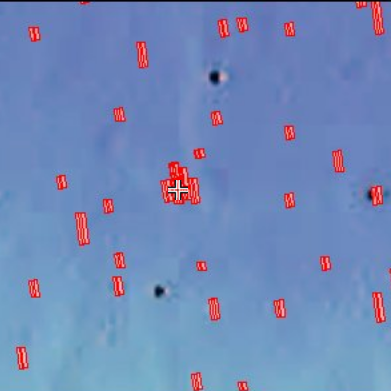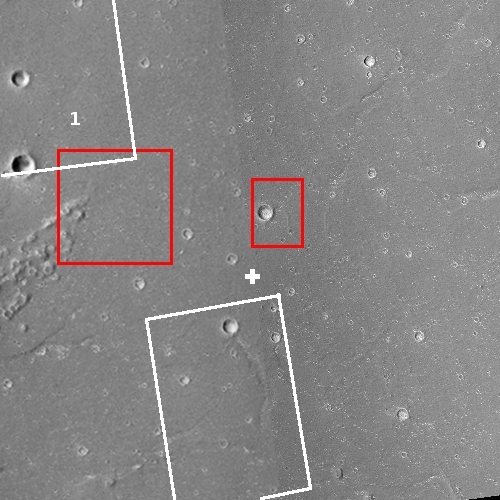Where is China’s Zhurong Mars rover?
At this moment we do not have confirmation that China’s rover Zhurong landed safely on Mars. Assuming it did, the mosaic to the right, made from two images from Mars Reconnaissance Orbiter’s (MRO) context camera, shows that landing zone, with the white cross indicating the centerpoint of the suspected landing site, as leaked to the Chinese press back in October 2020.
The red boxes are the only two images released by China that were taken by its Tianwen-1 orbiter of this landing zone. The two white boxes show the areas covered by two of the seven or so photographs taken by MRO’s high resolution camera since that location was revealed. Below is a map showing all the images MRO has taken of this location.

The cross notes the centerpoint of the suspected landing zone. The red boxes mark all the photos taken by MRO’s high resolution camera. The science team clearly has been trying to get full coverage of this spot so they can make a before and after comparison.
The second picture below shows the area centered around the #1 in mosaic above, taken by MRO on January 15, 2021.. As you can see, there are some craters in this relatively flat area. If you look at the full image you will see a number of other craters as well. You can also see a distinct rough region just to the south of this picture and covered by Tianwen-1’s image.
If Zhurong’s lander landed on any of this rough terrain it could have landed badly.
It is also possible that China has picked a slightly different location than this, and simply hasn’t told us. If so, none of the MRO high resolution images might find Zhurong. The lander could have come down a few miles to the east, west, north, or south, completely out of the area the MRO science team has been trying to cover.
If so, without further information from Chinese officials about the actual landing site, it could take months, even years, to find it, especially if it has crashed.
For the sake of science, and to enhance and not denigrate China’s image to the world, it behooves them to tell us soon everything they know about the state of their Mars rover. The longer they delay the worse they will look. As I wrote earlier today,
Despite more than 48 hours having passed since China announced the successful landing of its Zhurong rover on Mars in the northern lowland plain of Utopia Planitia, no images or data of any kind has been released by that nation or its space agency.
It is very possible that this is totally expected, since they have always said they will need about a week of checkouts before they rollled the rover off the lander and begin its operations.
At the same time, China has been very very creative with providing early images for all its planetary missions. For example, within hours of landing they had released images from their Chang’e-5 lunar sample return lander. Similarly, only hours after Chang’e-4 landed on the far side of the Moon with its Yutu-2 rover China released images.
They did the exact same thing when Chang’e-3 landed in 2013 with its Yutu-1 rover.
I can’t imagine they don’t have some cameras on the Mars lander to snap pictures of the horizon or the ground directly below. They might not, but if so the lack would be truly astonishing.
It is also possible China is holding the data close for any number of political reasons, though this doesn’t make much sense since the whole political point of these planetary missions is to sell China to the world.
The more time that passes with no confirmation data, the more it will appear that something is wrong. If this conclusion is incorrect, China needs to act now to dispel these doubts.
On Christmas Eve 1968 three Americans became the first humans to visit another world. What they did to celebrate was unexpected and profound, and will be remembered throughout all human history. Genesis: the Story of Apollo 8, Robert Zimmerman's classic history of humanity's first journey to another world, tells that story, and it is now available as both an ebook and an audiobook, both with a foreword by Valerie Anders and a new introduction by Robert Zimmerman.
The print edition can be purchased at Amazon or from any other book seller. If you want an autographed copy the price is $60 for the hardback and $45 for the paperback, plus $8 shipping for each. Go here for purchasing details. The ebook is available everywhere for $5.99 (before discount) at amazon, or direct from my ebook publisher, ebookit. If you buy it from ebookit you don't support the big tech companies and the author gets a bigger cut much sooner.
The audiobook is also available at all these vendors, and is also free with a 30-day trial membership to Audible.
"Not simply about one mission, [Genesis] is also the history of America's quest for the moon... Zimmerman has done a masterful job of tying disparate events together into a solid account of one of America's greatest human triumphs."--San Antonio Express-News
At this moment we do not have confirmation that China’s rover Zhurong landed safely on Mars. Assuming it did, the mosaic to the right, made from two images from Mars Reconnaissance Orbiter’s (MRO) context camera, shows that landing zone, with the white cross indicating the centerpoint of the suspected landing site, as leaked to the Chinese press back in October 2020.
The red boxes are the only two images released by China that were taken by its Tianwen-1 orbiter of this landing zone. The two white boxes show the areas covered by two of the seven or so photographs taken by MRO’s high resolution camera since that location was revealed. Below is a map showing all the images MRO has taken of this location.

The cross notes the centerpoint of the suspected landing zone. The red boxes mark all the photos taken by MRO’s high resolution camera. The science team clearly has been trying to get full coverage of this spot so they can make a before and after comparison.
The second picture below shows the area centered around the #1 in mosaic above, taken by MRO on January 15, 2021.. As you can see, there are some craters in this relatively flat area. If you look at the full image you will see a number of other craters as well. You can also see a distinct rough region just to the south of this picture and covered by Tianwen-1’s image.
If Zhurong’s lander landed on any of this rough terrain it could have landed badly.
It is also possible that China has picked a slightly different location than this, and simply hasn’t told us. If so, none of the MRO high resolution images might find Zhurong. The lander could have come down a few miles to the east, west, north, or south, completely out of the area the MRO science team has been trying to cover.
If so, without further information from Chinese officials about the actual landing site, it could take months, even years, to find it, especially if it has crashed.
For the sake of science, and to enhance and not denigrate China’s image to the world, it behooves them to tell us soon everything they know about the state of their Mars rover. The longer they delay the worse they will look. As I wrote earlier today,
Despite more than 48 hours having passed since China announced the successful landing of its Zhurong rover on Mars in the northern lowland plain of Utopia Planitia, no images or data of any kind has been released by that nation or its space agency.
It is very possible that this is totally expected, since they have always said they will need about a week of checkouts before they rollled the rover off the lander and begin its operations.
At the same time, China has been very very creative with providing early images for all its planetary missions. For example, within hours of landing they had released images from their Chang’e-5 lunar sample return lander. Similarly, only hours after Chang’e-4 landed on the far side of the Moon with its Yutu-2 rover China released images.
They did the exact same thing when Chang’e-3 landed in 2013 with its Yutu-1 rover.
I can’t imagine they don’t have some cameras on the Mars lander to snap pictures of the horizon or the ground directly below. They might not, but if so the lack would be truly astonishing.
It is also possible China is holding the data close for any number of political reasons, though this doesn’t make much sense since the whole political point of these planetary missions is to sell China to the world.
The more time that passes with no confirmation data, the more it will appear that something is wrong. If this conclusion is incorrect, China needs to act now to dispel these doubts.
On Christmas Eve 1968 three Americans became the first humans to visit another world. What they did to celebrate was unexpected and profound, and will be remembered throughout all human history. Genesis: the Story of Apollo 8, Robert Zimmerman's classic history of humanity's first journey to another world, tells that story, and it is now available as both an ebook and an audiobook, both with a foreword by Valerie Anders and a new introduction by Robert Zimmerman.
The print edition can be purchased at Amazon or from any other book seller. If you want an autographed copy the price is $60 for the hardback and $45 for the paperback, plus $8 shipping for each. Go here for purchasing details. The ebook is available everywhere for $5.99 (before discount) at amazon, or direct from my ebook publisher, ebookit. If you buy it from ebookit you don't support the big tech companies and the author gets a bigger cut much sooner.
The audiobook is also available at all these vendors, and is also free with a 30-day trial membership to Audible.
"Not simply about one mission, [Genesis] is also the history of America's quest for the moon... Zimmerman has done a masterful job of tying disparate events together into a solid account of one of America's greatest human triumphs."--San Antonio Express-News




Inconceivable! You’re seriously not going to just take China at its word? What possible reason could you have to doubt them, Bob? For them to attempt to deceive us would be absolutely, totally, and in all other ways inconceivable! ;-)
Great Galactic Ghoul STILL hungry! Take-out not filling.
Have Energia bring borsht.
Hulk, out!
I seem to recall that there were quite a few American/ESA Mars landers that didn’t survive the attempted landing.
Kenneth Michell: Your memory is wrong. The U.S. has only had one failed Mars lander, Mars Polar Lander. It has had no rover failures out of five attempts. Europe has as yet not tried to land anything on Mars. The UK tried to put a lander down as a ride share on a NASA mission, dubbed Beagle, but that failed.
All the other Mars lander/orbiter failures were from Russia, with most during the Soviet-era.
When any NASA or JPL spokesman tries to fear-monger how difficult it is to land on Mars, and cites the horrible statistic that says “about half of all missions failed,” they are misusing statistics to fake things. The U.S. has a stellar record. Russia does not. That is the only reason so many Mars landers have failed.
As a UKean, I have to correct you Bob, we made a successful landing with Beagle 2, in as much as it was a soft landing, not a crash. The lander began to open it’s solar panels, but due to either a hardware failure or an unlucky landing spot it failed to open fully. It got there in one piece tho.
Admittedly it was a ride share, but not with NASA, it was with the very successful ESA “Mars Express” orbiter mission. ( Still ongoing 18 years later! ) The total cost of the actual lander was only $120 million. A pittance compared to any other Mars mission. All of which actually proves your point, landing on Mars is not as difficult as sometimes made out!
(For the Mars curious, it is well worth checking out the website http://www.esa.int/Science_Exploration/Space_Science/Mars_Express
They are a bit slow in releasing images, but the ones they do are usually stunning, including many in old fashioned red/green glasses 3D!)
“Europe has as yet not tried to land anything on Mars.”
Au contraire, the EU attempted a Mars landing in 2016, with a lander named Schiaparelli. It splattered after apparently tumbling out of control because of software deficiencies. The rumor that the entire development staff was canned, but immediately rehired by Boeing for their exceptionally modest compensation expectations, is completely unfounded.
Ray Van Dune: I stand corrected. I was confusing Beagle with Schiaparelli, and combining them in my mind. Both however sadly rank in the end as failures.
Demonstrates the danger of depending on one’s memory, eh?
I had also forgotten about Schiaparelli, I put that down to selective memory! I still stand by point regarding Beagle as not being a landing failure.
Probably no photos from Mars until the end of the month… According to the Chinese space agency….
http://www.cnsa.gov.cn/english/n6465652/n6465653/c6812005/content.html
It probably landed on ours, by mistake of course.
For those of you that cannot be bothered to explore my link…. Here is a quote
“Wu said that more than half of the over 20 Mars landing attempts made by spacefaring nations so far failed due to the exceptionally difficult nature of such maneuvers.”
Kinda says it all really…lol…
Lee Stevenson: I just explained in a previous comment that statements like this misconstrue the reality. Almost all of the failures were by the Russians. Everyone else, especially the U.S., has a relatively good track record, succeeding almost all the time.
This is not to say this is easy. It is merely to note that the real odds are hidden because during the Soviet era the Russians lost a lot of Mars landers because of a systematic problem with the computer chips they used.
Also, It is easy to conflate failures of non-landing missions such as the infamous Mars Climate Orbiter with landing failures.
@Bob, if you care to take the time to read my comments on this thread you might notice I actually agree with you. I was pointing out the irony of the Chinese using the same old trope as NASA, hence the lol at the end of my last comment.
Robert Zimmerman, I am intrigued by your statement “…the Russians lost a lot of Mars landers because of a systematic problem with the computer chips they used.” First I have heard of that! Where can we find out more?
Ray Van Dune: When I was researching my Chronological Encyclopedia (presently out of print) I learned of this fact. See the text in this link from NASA.
@Bob, I agree with Ray Van Dune’s question… It’s the first I have heard about chip failure on the Russian missions also .. more info would be appreciated.
Oops… Posted too late… Sorry!
Ray,
They had soft errors. It was in a 2012 issue of IEEE Spectrum written by James Oberg: https://spectrum.ieee.org/aerospace/space-flight/did-bad-memory-chips-down-russias-mars-probe?utm_source=techalert&utm_medium=email&utm_campaign=022312
It was not only their Mars probe that had the problem with the chips, GLONASS had the same problem as well with cosmic rays.
Maybe those Russian systems were subjected to some form of Computational Inconsistency Augmentation?
Ray,
At first they blamed the chips as counterfeit. Then they blamed Radio Shack (just kidding). I know the story you are talking about with the Soviets getting hold of U.S. secrets, when reproduced that do not match up with the results.
I first learned of soft errors a few years ago when a device had several memory failures. We could add more shielding and increase the price or add error correction to the firmware which is cheaper. The error correction worked just fine.
the South China morning Post says that the Chinese have released images from the lander:
https://www.msn.com/en-xl/news/other/china-releases-first-images-of-mars-taken-by-zhu-rong-rover/ar-BB1gUnLK
First photos released, one from the rover, one from the lander…
https://www.theverge.com/2021/5/19/22443640/china-tianwen-1-first-images-zhurong-mars-rover-landing
I also read that the orbiter has now reached it final orbit…. I never considered that perhaps it needed to be in the correct orbit to relay data after dropping the rover off…. That makes nothing but sense…
Thank you Bob and Lee for the photos. I see the high gain antenna has deployed.